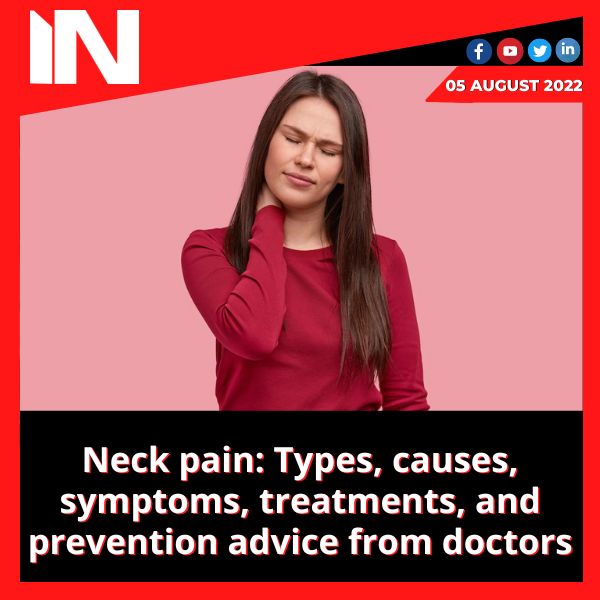Trending
Neck pain: Types, causes, symptoms, treatments, and prevention advice from doctors
Published
3 years agoon
By
India
One in three people experience neck pain at least once a year, making it one of the most prevalent musculoskeletal disorders. It can be mild or severe, spread to our arms and shoulders, and cause headaches. Neck pain or discomfort is a multifactorial disease that can reduce productivity and efficiency, but it can also be managed with a healthy lifestyle that includes regular exercise, a balanced diet, and a good work-life balance.
Types:
Neck pain can come in a variety of forms, according to Dr. Jagjit Singh, Senior Orthopaedic Consultant at Mata Chanan Devi Hospital in Janakpuri, Delhi. Common types include the following.
1. Occipital Neuralgia – This type of headache causes pain in the back of the head, the area behind the ears, and the upper neck. Occipital neuralgia is brought on by inflammation or injury to the occipital nerves, which run through the scalp.
2. Cervical Radiculopathy – Also referred to as a pinched nerve, this condition typically results from a herniated disc in the neck. As a result, the neck, shoulder, arm, and fingers may experience excruciating pain. One of the most agonising neck conditions, thankfully with a favourable prognosis.
Facet arthropathy is a well-known cause of neck pain and the term implies that the small vertebral joints in the neck are affected by arthritis. It might be brought on by illnesses like rheumatoid arthritis or ageing.
4. Myofascial Pain Syndrome – Neck muscles and fascia are impacted by this chronic pain condition. One of the body parts where Myofascial Pain Syndrome can manifest is the lower and upper back, neck, shoulders, and chest. This could be caused by the repetitive motions people do at work, stress-related muscle tension, muscle injuries, bad posture, or inactive muscle groups.
5. Cervical Spondylosis – Cervical spondylosis is the name for age-related wear and tear in the cervical spine that causes neck pain and stiffness.
6. Whiplash Neck Sprain – This occurs when your neck sustains rapid trauma as a result of an accident, auto collision, etc.
7. Fibromyalgia – This condition is characterised by widespread musculoskeletal pain and may also cause sleep, memory, and mood problems. Most people have back and neck pain that is very severe and stiff.
Causes:
Dr. Vivek Loomba, a pain management specialist at The Indian Spinal Injuries Center in Vasant Kunj, New Delhi, listed a few typical causes of neck pain:
1. Physical strain – The most frequent cause of neck pain, this condition is brought on by overusing the neck muscles during strenuous physical activity, weight lifting, toting heavy objects on the shoulder, long distance driving, etc. All of these activities could result in neck pain from strained neck muscles or ligaments. On rare occasions, it could lead to a disc herniation, which could result in neck pain that travels down the arm.
2. Posture – One of the main contributors to neck pain is poor posture. Using smartphones and laptops for extended periods of time while hunched over with the neck bent forward (text neck syndrome) places more strain on the cervical spine, leading to cervical degeneration, stiffness, and pain. According to Dr. Loomba, the number of students attending school has steadily increased.
3. Whiplash injury – A sudden, jerky movement of the neck during a car accident can cause whiplash injury, which causes neck pain.
4. Arthritis – Neck pain may be brought on by arthritis in the neck’s vertebral joints.
5. Other – Neck pain can have other causes, such as stress, depression, infection, tumours, etc.
Symptoms:
According to Dr. Jagjit Singh, neck pain can range from a nagging, irritating ache to a burning, incapacitating nerve pain that may radiate down the shoulder and into the arm. Dr. Singh emphasised the importance of making the right diagnosis before beginning any treatment because the aetiology of the disease determines how it should be treated.
Aside from neck pain, other symptoms can include:
1. Migraine
2. A sleep disorder
3. Neck discomfort or fatigue
4. Poor sleep quality
5. Arms or fingers that are numb or tingly
6. Arm-reaching pain or a weakness
7. Occasionally losing control of one’s bowels or bladder
Taking care of neck pain
The majority of neck pain problems go away on their own in a few days, but according to Dr. Singh, you should seek medical attention if you experience severe pain, persistent discomfort, or neck pain that interferes with your daily activities. He went on to explain that an orthopaedic doctor or a pain management doctor can assist you by attending to your problem and by recommending one or a combination of therapies.
Since most neck pains are benign, surgery is rarely necessary. There are numerous treatments available, depending on the cause and degree of the neck discomfort.
Treatment:
The best results for treating neck pain have consistently been seen with a multimodal approach. Dr. Vivek Loomba lists the following as the most typical neck pain treatments:
Acetaminophen (crocin), non-steroidal anti-inflammatory drugs (NSAIDs) like ibuprofen, muscle relaxants like myoril, and weak opioids like tramadol are just a few of the medications that are commonly prescribed.
One of the most popular treatments for persistent neck pain is physiotherapy. Stretching and strengthening neck muscles and tendons are the main goals of physical therapy.
3. Hot Fomentation – Heat application to the affected area may provide effective symptom relief.
4. Injections – A quick procedure is another option for treating neck pain. Occipital nerve blocks, epidural injections, facet joint injections, and trigger point injections are a few examples. For long-lasting relief, radiofrequency ablation of the occipital nerves and facet joints can also be done. Patients with chronic neck pain have shown to experience pain relief from these procedures.
5. Surgery – The majority of neck pain sufferers benefit from conservative and non-surgical treatment options. Rarely, surgery is the only treatment available. If urgent surgical exploration is not done, patients who present with neck trauma, such as from car accidents, may be at risk of paralysis. Similar to this, people with disc herniation may experience upper limb weakness that necessitates immediate surgery. Patients and their families should keep in mind that in these situations, urgent surgery may be life-saving, and any delay in making a choice could have terrible, and in some cases, potentially fatal, consequences.
Prevention advice
Dr. Jagjit Singh contends that minor lifestyle adjustments can significantly reduce the risk of ailments like neck pain. These consist of:
1. Maintain the proper body posture. The bones and joints are in alignment with the right posture, preventing muscle strain and the ensuing pain.
2. Neck pains may be avoided by leading a healthy lifestyle that includes daily neck stretches and 10 to 15 minutes of neck exercises while using a phone or computer.
3. Steer clear of lifting anything heavy because it could hurt your neck.
4. Wear a seat belt; it may offer some protection in the event of a motor vehicle accident.
5. Seek assistance – If you experience chronic neck pain, please visit your pain specialist or an orthopaedic doctor. Self-medication could delay proper care, making the issue worse.
If you experience neck pain, you should see your doctor as soon as possible because there are many different causes of neck pain. The majority of neck pains may go away on their own with rest and activity modification, but sporadic neck pains may be indicative of a more serious pathology and necessitate specialised care.
Group Media Publications
Entertainment News Platforms – anyflix.in
Construction Infrastructure and Mining News Platform – https://cimreviews.com/
General News Platform – https://ihtlive.com/
Legal and Laws News Platforms – https://legalmatters.in/
Podcast Platforms – https://anyfm.in/
You may like
-


Virat Kohli’s invaluable advice after kid asks how to represent Team India: ‘Your father shouldn’t tell you to…’
-


Doctors actors Harleen Sethi and Sharad Kelkar claim that OTT makes realism possible: “You couldn’t even depict death on TV” | Exclusive
-


Kareena Kapoor says ‘Taimur probably doesn’t even know all the drama’ that erupted around his name
-


Do you lose more hair after shampooing? Here are some quick fixes and advice to stop it
-


Nutritional advice for nursing mothers to prevent monkeypox during World Breastfeeding Week
-


The $14k V-neck dress worn by Kareena Kapoor in her most recent post from her vacation to Europe
Trending
Thug Life Movie Review & Release Live Updates: Kamal Haasan’s Bold New Venture – Is it the Hit We Expected?
Published
2 weeks agoon
June 5, 2025By
India
Kamal Haasan’s Bold New Venture
Kamal Haasan, the versatile legend of Indian cinema, is back on the big screen with his latest thriller, Thug Life. After weeks of anticipation and a gripping promotional campaign, fans have eagerly awaited the release of this high-octane action drama. The movie, directed by debutant director Arvind Rao, promises to showcase Haasan in a never-before-seen avatar, leading to sky-high expectations. So, does Thug Life live up to the hype? In this blog, we bring you an in-depth review of the film, along with live updates from the first-day box office response. Is Thug Life the next blockbuster hit Kamal Haasan fans have been waiting for?
A Thrilling First Look: What’s Thug Life All About?
At its core, Thug Life is an action-packed thriller that explores the lives of notorious criminals, their complex relationships with law enforcement, and the grey areas of morality. Kamal Haasan plays Vikram Singh, a larger-than-life anti-hero with a troubled past who finds himself caught between the law and the underworld. The film also stars an ensemble cast, including the brilliant actress Simran, who plays a key role as Vikram’s moral compass.
From the first teaser, it’s clear that Thug Life is set against the backdrop of a gritty urban world, filled with explosive action sequences, intense drama, and gripping twists. The film promises to delve deep into themes of justice, vengeance, and personal redemption. Kamal’s performance, combined with the intriguing premise, has set the stage for a grand theatrical release.
Plot and Direction: The Power of Storytelling
Thug Life is crafted in a fast-paced manner, with suspense building at every corner. The screenplay is written in a way that constantly keeps the audience on edge, making them question the true intentions of the characters. The film’s direction by Arvind Rao has been appreciated for its bold approach in showcasing complex characters and real-world dilemmas.
Kamal Haasan, known for his ability to transform into any character, does not disappoint here. He brings his unparalleled experience to the table, portraying a character who walks the thin line between good and evil. His performance is undoubtedly one of the highlights of the film.
Simran’s portrayal of Maya, a fierce and intelligent woman who challenges Vikram’s decisions, complements Haasan’s character beautifully. Their chemistry on screen elevates the emotional stakes, making the action sequences more impactful.
Is the Action Worth the Hype?
The action sequences in Thug Life are nothing short of spectacular. From high-speed chases to hand-to-hand combat, the film delivers thrills on every front. The choreography, especially in the fight scenes, stands out for its fluidity and precision. Kamal Haasan, known for his commitment to physical transformation, performs many of the stunts himself, showcasing his dedication to the craft.
One of the standout moments is a tense sequence set in an abandoned warehouse where Vikram faces off against a group of armed criminals. The scene is intense, and the cinematography captures the chaos and confusion, making it a thrilling experience.
Music & Sound Design: A Powerful Impact
The film’s music, composed by the talented Anirudh Ravichander, perfectly complements the high-octane action and dramatic moments. Tracks like “Thug Life Anthem” and “Vikram’s Vengeance” have already started to trend on music platforms, and it’s easy to see why. The music amplifies the tension and excitement, enhancing the overall cinematic experience.
The sound design deserves special mention. Whether it’s the ominous hum during a quiet moment or the deafening roar during action sequences, the sound elevates the tension and immerses the audience in the world of Thug Life.
Live Box Office Updates: A Promising Start
As the clock strikes midnight, audiences flock to theaters for the first showings of Thug Life. Early reviews on social media are buzzing with excitement, praising Kamal Haasan’s return to form and the gripping narrative. The film’s powerful action sequences and engaging storyline seem to have hit the right chord with fans.
Box office analysts predict a solid opening for Thug Life. With strong pre-release bookings, particularly in Chennai, Mumbai, and Bengaluru, the film is set for a roaring start. Kamal Haasan’s massive fan base is ensuring long lines at theaters, with advance bookings already sold out in several locations.
Reports from the first-day collections are already rolling in, and the numbers look promising. It’s expected that Thug Life will gross over ₹15 crore on its opening day, making it one of the highest openings for Kamal Haasan in recent years.
The Verdict: Is Thug Life Impressive?
Without a doubt, Thug Life is a powerful cinematic experience that showcases Kamal Haasan in peak form. The film succeeds in offering a gripping storyline, memorable characters, and a stellar performance from its lead. The action sequences and emotional depth set it apart from typical masala entertainers, and its themes resonate with today’s audience.
While the plot may feel familiar to those who have watched similar thrillers, Thug Life distinguishes itself with its sharp direction, compelling performances, and high-quality production values. If you’re a fan of action films with emotional depth, this is a movie you won’t want to miss.
Rating: 4/5 – A must-watch for Kamal Haasan fans and action movie lovers alike.
Live Updates: Is Thug Life Making Waves?
10:00 AM – First Show Starts:
The first show has begun! Fans are already praising Kamal Haasan’s power-packed performance. Social media is flooded with reactions as people seem impressed with the intense action sequences.
12:30 PM – Early Box Office Numbers:
Thug Life is seeing a great response at the box office. Early reports show packed theaters in Chennai, Hyderabad, and Bengaluru. Looks like Kamal Haasan is in for a hit!
3:00 PM – Social Media Buzz:
The film’s action and Kamal Haasan’s performance are trending on Twitter and Instagram. Fans are calling it his best role in years. Many are also impressed with the music by Anirudh.
6:00 PM – Fan Reactions:
The film continues to dominate social media as fans share videos from theaters. There’s a lot of love for the film’s emotional depth, making it clear that Thug Life is a crowd favorite.
Final Thoughts:
With such a fantastic opening, Thug Life looks set to make waves at the box office. Kamal Haasan’s stellar performance and the film’s impressive direction ensure that this thriller is more than just a typical action flick – it’s a cinematic experience.

.jpg)
They said Vidhu Vinod Chopra bribed me with Rs 8 crore to not make OMG’: Director Umesh Shukla opens up on PK comparisons
.jpg)
Stranded in Israel amid airstrikes, Caitlyn Jenner sips wine in bomb shelter and says, ‘Pray for us’
.jpg)
After three years, Alia Bhatt and Ranbir Kapoor’s six-story Bandra home, valued at Rs 250 crore, is ready, and fans exclaim, “Gate nahi hai.” Observe

Paresh Rawal responds to a fan who refers to him as the “hero” of Hera Pheri 3 and asks him to reevaluate his departure: “There are three heroes.”
.jpg)
Housefull 5 Day 3 Box Office Collection: ₹91 Cr Milestone for Akshay Kumar
.png)
Four years after her divorce, did Samantha Ruth Prabhu get rid of her tattoo with the Naga Chaitanya link? Supporters are persuaded

Thug Life Movie Review & Release Live Updates: Kamal Haasan’s Bold New Venture – Is it the Hit We Expected?
.jpg)
‘Deepika Padukone was in a relationship with me for two years, I broke up with her,’ says Muzammil Ibrahim: ‘We went on dates in a rickshaw’
.jpg)
Housefull 5 Box Office Collection Prediction: Will the latest Housefull movie end Akshay Kumar’s streak of duds? Film projected to earn Rs 200 crore
%20(2).jpg)
Kareena Kapoor reveals her new schedule; says she has dinner at 6pm, lights out at 9:30 pm: ‘Saif, the kids and me, we’re all cooking together’

According to Urvashi Rautela, Leonardo DiCaprio referred to her as the Queen of Cannes; online users refer to him as the “first Hollywood star to

First impression of a good boy: Don’t let “Pouty” Park Bo Gum deceive you; he’s throwing punches of his career.

Thug Life Movie Review & Release Live Updates: Kamal Haasan’s Bold New Venture – Is it the Hit We Expected?
.png)
Four years after her divorce, did Samantha Ruth Prabhu get rid of her tattoo with the Naga Chaitanya link? Supporters are persuaded

Gauahar Khan criticises Suniel Shetty’s C-section remark, reveals she suffered a miscarriage: ‘For a male celebrity who didn’t go through pregnancy…’
%20(1).jpg)
Actor Hailee Steinfeld marries Buffalo Bills quarterback Josh Allen in dreamy ceremony
.jpg)
Stranded in Israel amid airstrikes, Caitlyn Jenner sips wine in bomb shelter and says, ‘Pray for us’
.jpg)
“I haven’t seen a man with such great kindness,” Zeeshan Ayyub remembers when Shah Rukh Khan handed him his own sweater.

Thug Life Movie Review & Release Live Updates: Kamal Haasan’s Bold New Venture – Is it the Hit We Expected?

The anime Tokyo Revengers is back with a sequel: view the promotional trailer

Deadpool and Wolverine might shatter box office records, which would be unprecedented for an R-rated film.

Review of Bridgerton Season 3 Part 2: Nicola Coughlan excels in the most intricate and captivating season to date

Kartik Aaryan Gives a Career-Defining Performance in Chandu Champion First Review; An Excellent Biopic

Watch the trailer for Kota Factory 3 here. Fans of Jeetu Bhaiya say they’re not ready for it to end.

Kartik Aaryan on overcoming the label of “outsider”: It will remain with me, and that is alright with me.

When Does Vishwak Sen’s Film Gangs of Godavari OTT Come Out? What Platform Does It Come Out On?

Review of Gullak 4: A lovely, sentimental, and somewhat mature reunion of the Mishra family
Trending
-

 Ranbir Kapoor2 months ago
Ranbir Kapoor2 months agoRanbir Kapoor and Alia Bhatt inspect their new dream home in Mumbai days after anniversary
-

 Mahakumbh2 months ago
Mahakumbh2 months agoMahakumbh viral girl Monalisa looks unrecognisable after glamorous transformation in new videos: Watch
-

 American Dream1 month ago
American Dream1 month agoThe new American dream’: Meet the US expat who built a $23M food business in India
-
.jpg)
.jpg) Bollywood1 month ago
Bollywood1 month agoSiddharth Malhotra carries pregnant wife Kiara Advani’s bag in unseen pic from New York ahead of Met Gala 2025
-

 Sunny Leone2 months ago
Sunny Leone2 months agoSunny Leone’s fitness secrets for toned body at 43: Vegetarian diet to different menu every day for lunch and dinner
-

 SSC Exam Calendar 20251 month ago
SSC Exam Calendar 20251 month agoSSC Exam Calendar 2025 revised, check CGL, CHSL, SI in Delhi Police, MTS, JE and other exam dates here
-

 Parineeti Chopra2 months ago
Parineeti Chopra2 months agoParineeti Chopra has the ‘best sensations’ as Raghav Chadha recreates her viral Hasee Toh Phasee reel. Watch
-

 Ajith Kumar2 months ago
Ajith Kumar2 months agoAjith Kumar says he could be ‘forced into retirement’, calls himself an ‘accidental actor